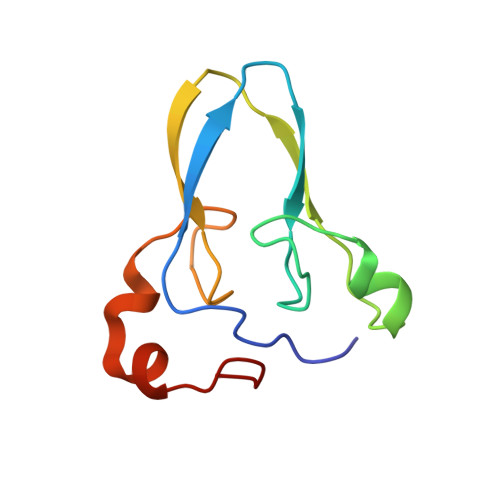Structure of the human monomeric NEET protein MiNT and its role in regulating iron and reactive oxygen species in cancer cells.
Lipper, C.H., Karmi, O., Sohn, Y.S., Darash-Yahana, M., Lammert, H., Song, L., Liu, A., Mittler, R., Nechushtai, R., Onuchic, J.N., Jennings, P.A.(2018) Proc Natl Acad Sci U S A 115: 272-277
- PubMed: 29259115
- DOI: https://doi.org/10.1073/pnas.1715842115
- Primary Citation of Related Structures:
6AVJ - PubMed Abstract:
The NEET family is a relatively new class of three related [2Fe-2S] proteins (CISD1-3), important in human health and disease. While there has been growing interest in the homodimeric gene products of CISD1 (mitoNEET) and CISD2 (NAF-1), the importance of the inner mitochondrial CISD3 protein has only recently been recognized in cancer. The CISD3 gene encodes for a monomeric protein that contains two [2Fe-2S] CDGSH motifs, which we term mitochondrial inner NEET protein (MiNT). It folds with a pseudosymmetrical fold that provides a hydrophobic motif on one side and a relatively hydrophilic surface on the diametrically opposed surface. Interestingly, as shown by molecular dynamics simulation, the protein displays distinct asymmetrical backbone motions, unlike its homodimeric counterparts that face the cytosolic side of the outer mitochondrial membrane/endoplasmic reticulum (ER). However, like its counterparts, our biological studies indicate that knockdown of MiNT leads to increased accumulation of mitochondrial labile iron, as well as increased mitochondrial reactive oxygen production. Taken together, our study suggests that the MiNT protein functions in the same pathway as its homodimeric counterparts (mitoNEET and NAF-1), and could be a key player in this pathway within the mitochondria. As such, it represents a target for anticancer or antidiabetic drug development.
Organizational Affiliation:
Department of Chemistry and Biochemistry, University of California, San Diego, La Jolla, CA 92093.















